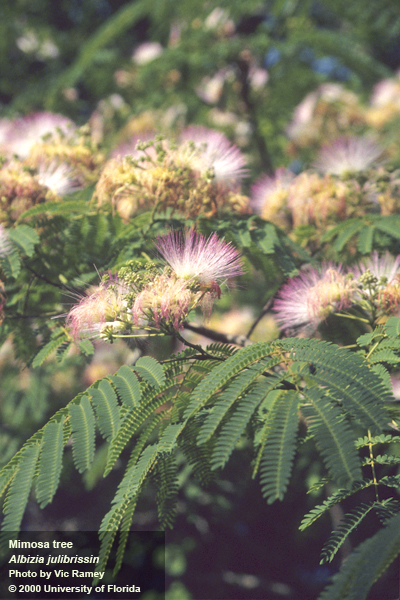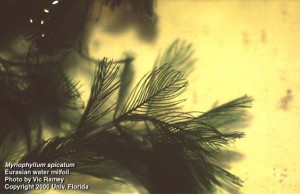Mimosa Tree: When traveling down secluded roads, one always marvels at the beautiful fragrant puff-like flowers lining the right of way. Many people decide that they must have one for their yard. Unfortunately, obtaining one for landscaping purposes is a bad decision. This tree is a Mimosa, Albizia julibrissin, and is famous for the ability to thrive in disturbed areas and fix nitrogen. Mimosa was brought from China in the 1700 for use as an ornamental and remains popular today. Unfortunately it crowds out native vegetation by reducing sunlight and nutrients available and may clog small waterways with intense growth. What’s more, it produces numerous seed that can remain viable for many years and is capable of vegetative propagation. Fortunately, Mimosa may be controlled by a variety of techniques. Eliminating existing trees mechanically, such as with a power saw, will reduce future numbers substantially. Additionally, the application of a 25% solution of glyphosate or triclopyr herbicide to a freshly cut stump will prevent re-sprouting of cut trees. When applying herbicides, apply them only to the stump and not to surrounding areas. Remember to make the application within one minute of cutting the tree. Enjoy your invasive removal!
For more information, contact the author Matt Orwat, Horticulture Extension Agent 850-638-6180.
Video courtesy of UF/IFAS Center for Aquatic and Invasive Plants
Eurasian Water Milfoil: Eurasian water milfoil is a submerged aquatic plant that can be found in northwest Florida in lakes, rivers, and coastal marshes. Water milfoil forms a dense mat of vegetation that can block sunlight and habitat for native plants. These mats can increase water temperatures and interfere with boat traffic, fish habitat, and native aquatic plant species. Eurasian milfoil was first documented in Florida in 1964. It was reportedly planted by aquarium plant dealers. It is still used today in the aquarium industry and obtained through suppliers and through internet sales. This plant is listed as a category II on the Florida Exotic Species Pest Plant Council List, which means it has the potential to overtake native submerged plant communities. The spread of Eurasian milfoil can be caused by the breaking of stems and roots, which can be carried by boats, engines and trailers to other lakes and coastal marshes. To help prevent spread of Eurasian water milfoil to Florida’s waters, always clean off your boat, motor and trailer at the ramp to avoid transporting vegetative stems to other areas. In addition, never release or dispose of aquarium plants or animals into local waterways.
For more information, contact the author Chris Verlinde, Marine Science Agent 850-623-3868.


